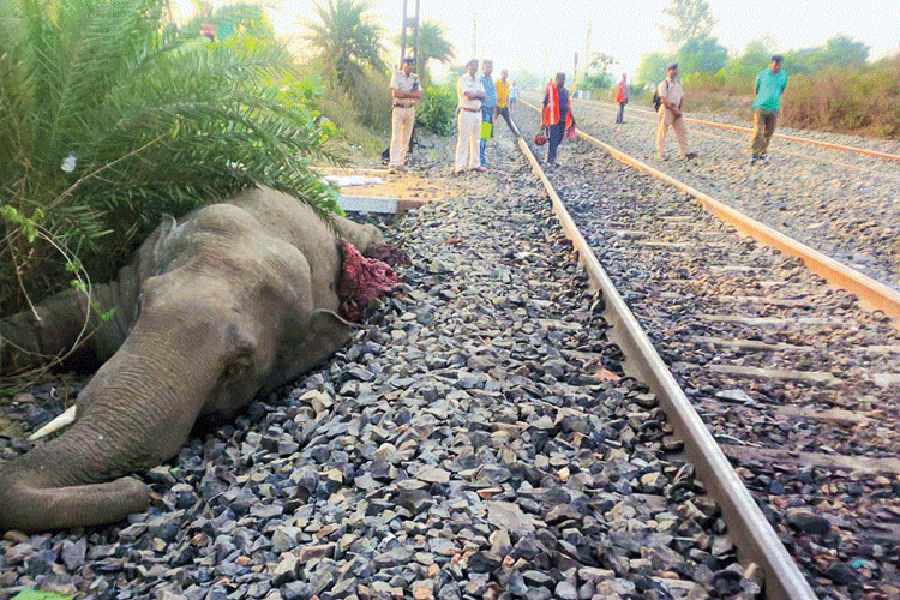Three elephants, including a six-month-old calf, were mowed down by a speeding goods train here on Monday, the tragedy taking the count of elephants killed on the railway tracks in north Bengal to 77 since 2004.
“One adult female along with a sub-adult male and a calf died of the collision (while) crossing the tracks,” said Parveen Kaswan, deputy field director, Buxa Tiger Reserve (West).
The incident took place between the Rajabhatkhawa and Garopara stations in
the section between Alipurduar Junction and Siliguri Junction, which comes
under North East Frontier Railway.
As trains in this section pass through the Buxa Tiger Reserve, Jaldapara, Chapramari and Mahananda forests — which have high elephant populations — collisions have been a regular affair. Particularly so, since the gauge conversion of 2003 led to an increase in the number of trains using the route and their speeds.
Over the last few years, the railways and the forest department have tried several measures to reduce animal casualties on the tracks.
According to a railway source, the pilot of a special goods train, travelling from Guwahati to Siliguri, spotted a herd of 10-odd elephants crossing the tracks between pillar numbers 154/7 and 154/8 around 7.15am.
“The train was moving at high speed.... The loco pilot used the emergency brakes but failed to save the last three elephants,” the source said.
The train first hit the mother elephant, flinging it about 20 metres to the left of the tracks, and then the sub-adult male of about 20 months, the source said.
Finally, the train hit the calf, which got dragged along the tracks for at least 50 metres.
“Usually the little members of the herd move at the rear with their mothers,” a forest department source said.
Multiple sources in the railways and the forest department said that the tusker leading the herd and the other members, which had crossed the tracks before the collision, stood at the spot after the accident.
“The herd members waited along the tracks for about an hour and that’s why it took us some time to reach the elephants hit by the train,” the forest department source said.
Foresters had to use sirens and crackers to disperse the herd before they could reach the three bleeding elephants.
The incident has thrown up uncomfortable questions for the railways.
“At times, loco pilots cannot spot a herd when the train takes a sharp bend or after sundown.... Here, the stretch was straight and the incident took place after sunrise.
“So, the most important question is, why did the loco pilot fail to spot the herd?” an environmentalist asked.
A railway source said a speed restriction of 30kmph is in place in this section between 5pm and 5am to reduce the possibility of accidents.
“The accident took place beyond the speed restriction period; the goods train was travelling at about 100km an hour,” the source said.
Ankit Gupta, divisional commercial manager (DRM), Alipurduar railway division, said an inquiry had begun.
“Elephant movements have increased in the section because of the new crop in the fields.... We have plans to install the Intrusion Detection System (IDS) in this section very soon, since this has yielded very good results in the 37km stretch between Madarihat and Nagrakata,” he said.
Gupta said that under the IDS, optical fibre cables laid along the tracks inform the control room immediately if any heavy animal comes within 10 metres of the tracks.
“Immediately, the control room cautions the loco pilot....
“Since the installation of the IDS in the 37km stretch, there has not been a single accident on the tracks. We have had trial runs in other stretches, and the IDS installation will be completed soon,” Gupta said.
Railway sources said the IDS had helped save at least 62 elephants in the past one year or so.
Kaswan said the Buxa Tiger Reserve authorities had written to the Alipurduar DRM to provide the speed logbook to them so they could ascertain the real reason behind the tragedy.
The accident disrupted train movement for about four hours.











